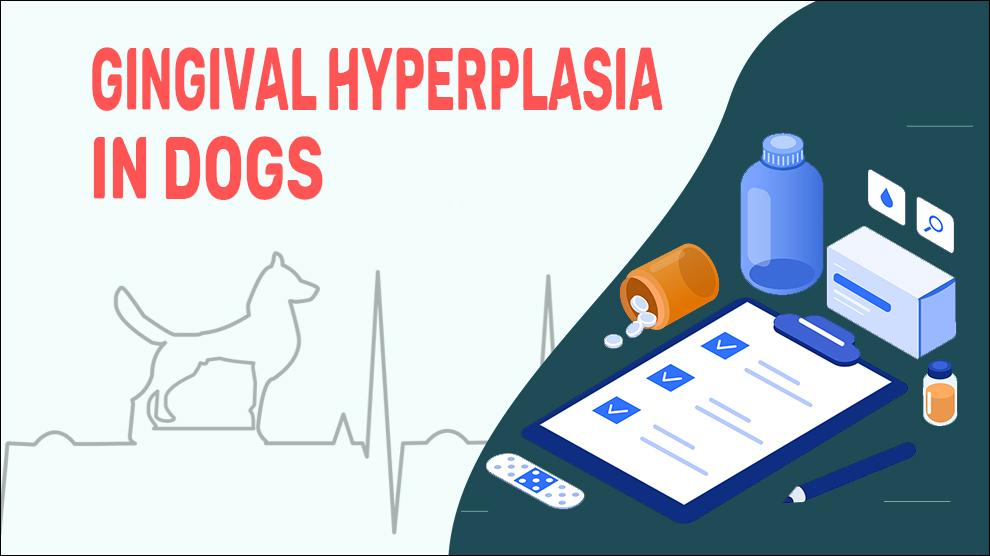What Is Gingival Hyperplasia In Dogs?
Gingival hyperplasia (GH) is an idiopathic, non-neoplastic, non-inflammatory, proliferation of tissue that occurs secondary to gum (gingival) tissue inflammation. Also called focal fibrous hyperplasia (FFH), gingival enlargement, or gum overgrowth, this refers to the increase in the size or thickness of gingiva, mainly the fibrous submucosa that typically occurs in response to chronic gingivitis.
This also occurs due to a chronic inflammatory response to food impaction, dental malposition, dental resorptive lesions, and the bacteria in plaque. Gingival hyperplasia is a nodular or avascular smooth enlargement of the gingiva with the slow development of a firm gingival margin. This can be localized or symmetrical and can include one or several dental quadrants.
The gingival hyperplasia progresses slowly, if not complicated by secondary infection or trauma. At the outset, FFH involves the marginal contour of the gingiva as it evolves afterward and it can almost totally envelop the crowns of the teeth. Most commonly, the painless enlargements that are slowly growing become visible in teeth-occupied areas (edentulous space)
These lesions are generalized but can be localized, especially in breeds that are prone to be hereditarily affected.
Symptoms Of Gingival Hyperplasia In Dogs
- Slow abnormal to normal growth along the gingival margin
- Bleeding from the gums
- Redness in gums
- Bad breath (halitosis)
- Difficulty or pain with chewing
- Pus/mucous along the gum line, in nasal discharge
Treatment Options For Gingival Hyperplasia In Dogs
Treatment is not necessary for most GHs. However, rarely do the lesions get large and cause discomfort or other symptoms, then they will be surgically removed.
- Nutritional therapy and Intravenous fluid will be given to help your dog not become severely dehydrated.
- Anti-inflammatory or immunosuppressive medications.
- Gingivoplasty - when the lesion is large, this is done to remove excess tissue and red hape gum margin.
- Gingival curettage is the removal of infected, inflamed, necrotic, or damaged tissue from the periodontal pocket.
Home Remedies For Gingival Hyperplasia In Dogs
Don’t skip routine dental checkups and Consult with your vet for guidance on teeth brushing tips.
Make sure to provide plenty of drinking water.
Home remedies such as herbs, diet, and exercise will depend on your dog’s age and stage of the disease they are in.
How To Prevent Gingival Hyperplasia In Dogs?
- There is no confirmed way to prevent GH. However, proper hygiene practices can be followed.
- Brush the tooth using pet-safe enzymatic toothpaste that is specially formulated for dogs at least 2-4 times each week.
- Dental wipes, chewing toys for dogs, treats or oral rinses may also help decrease or delay plaque/tartar by reducing the build-up of saliva, food, and bacteria on the surface of the teeth and gums.
- Some exclusively formulated pet foods are used as dental diets with proven tartar-reducing ingredients.
- Water additives interfere with plaque development.
Affected Dog Breeds Of Gingival Hyperplasia
There is no breed restriction.
Most represented in Boxers, Dalmatians, Collies, Doberman, Mastiffs, Great Danes, and Retriever breeds
Causes And Types For Gingival Hyperplasia In Dogs
1. Causes:
- Congenital/ Idiopathic
- Medications that cause GH fall into three main categories as follows.
Immunosuppressants – Cyclosporine, prednisolone, prednisone, and chlorambucil.
Calcium channel blockers – Verapamil, diltiazem, and amlodipine.
Anticonvulsants – Phenobarbital, levetiracetam (Keppra) and Potassium bromide.
2. Types:
- Idiopathic GH – This is when the cause of this condition is unknown/ hereditary.
- Acquired - Chronic drug administration has been shown to cause GH.
3. Mortality:
There is no mortality associated with gingival hyperplasia documented yet.
The lesions do not need surgical resection unless they get bigger and symptoms persist.
4. Diagnosis:
- Routine dental exam
- Dental X-rays
5. Prognosis:
The prognosis for gingival hyperplasia is really good. This is a non-life-threatening condition, so no aggressive treatment is usually necessary. Though, recurrence is possible after the medical treatment in affected dogs. Proper hygiene and home care are the best defenses against future recurrences.
When To See A Vet For Gingival Hyperplasia In Dogs?
It’s better to set up an appointment with your veterinarian if you notice-
- Slow abnormal to normal growth long the gingival margin
- Bleeding from the gums
Food Suggestions For Gingival Hyperplasia In Dogs
- Provide a balanced diet - Select foods from all food groups: egetables, meats, grains, fruits, milk, and oil.
- Add lots of veggies (green leafy vegetables, broccoli, carrots, especially).
- Protein- Lean chicken or turkey breast, lean beef, and Cooked fish (salmon, tuna).
- antioxidants ndash; Blueberries, Cauliflower, Beets, Beans, etc.
- High fiber diet - boiled green peas, carrot, oatmeal, brown rice(cooked), lentils(boiled), black beans (boiled).
Conclusion
As most gingival hyperplasia for affected dogs is incidental and benign, they do not require treatment or monitoring over time. The Prognosis is also excellent. Some lesions are large and hamper oral function, they have warranted closer monitoring as they can lead to gum and periodontal disease.

















